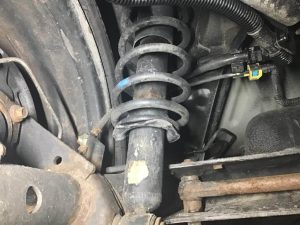Shock and Strut Replacement: How much wear and tear can they take?
 Shocks and struts are what make your ride smooth and comfy, even as your travel over rough terrain and bumpy roads (or a hallmark New England pothole).
Shock absorbers are mechanical or hydraulic devices that keep the car from bouncing as you drive. Struts, on the other hand, are a structural part of the suspension system that provide a mount for the coil spring (which maintains the height of the vehicle). Typically, shock absorbers provide better handling, while struts provide a lower initial cost for the vehicle.
Shocks and struts are what make your ride smooth and comfy, even as your travel over rough terrain and bumpy roads (or a hallmark New England pothole).
Shock absorbers are mechanical or hydraulic devices that keep the car from bouncing as you drive. Struts, on the other hand, are a structural part of the suspension system that provide a mount for the coil spring (which maintains the height of the vehicle). Typically, shock absorbers provide better handling, while struts provide a lower initial cost for the vehicle.
Wear and Tear
As your shocks or struts wear, they allow more dramatic up and down tire movement. As the tire bounces up, the tread’s contact with the pavement decreases. This loss of traction can create dangerous conditions when cornering, accelerating, and stopping short, especially if roads are wet or slippery. Simply put, more wear equals less vehicle control. In addition, worn shocks and struts will also increase the wear on other related vehicle components. More suspension movement is allowed when the shocks wear- this extra impact puts additional strain on parts like the suspension springs, support arms, bushings, joints, and wheel alignment, causing accelerated deterioration. That translates to additional repair expenses and could lead to a shorter vehicle lifespan.Warning Signs
While your shocks and struts can take on a lot of wear and tear, they may need to be replaced at some point. Here are a few warning signs to look out for:- Excessive bouncing: Shocks and struts are designed to control your car when you go over a bump and keep your car from bouncing non-stop. If you drive over a big bump, pothole, or a rough patch and your vehicle continues to bounce, your car may need a shock or strut replacement.
- Front “Nose-Diving”: Shock and struts help keep the car steady and stable at all times – whether you are braking, accelerating, or turning – so that you can maintain complete control as you drive. If the front end of your vehicle (otherwise known as the nose of your car) dives toward the ground when braking or dips drastically to one side while turning your shocks and struts need to evaluated.
- Decreased Performance: And as it wears, the suspension system may not perform as well as it originally did. You may notice less control when steering, that the car wanders slightly from side to side, increased bouncing, or “nose-diving” when braking. All of these symptoms are indicative of a serious problem.
- Leaking Fluid: Every shock and strut contains a piston and hydraulic fluid. When you drive over a bump or a rough stretch of road, the shocks or struts compress, the piston pushes against the hydraulic fluid, and the fluid absorbs the force of the piston. If the system is damaged or worn, that fluid that can leak out of the shock or strut. A little leakage is perfectly normal, but if the strut looks wet and oily that’s cause for concern.

